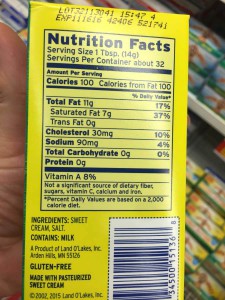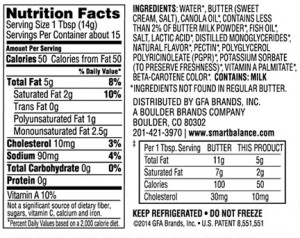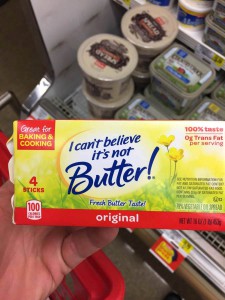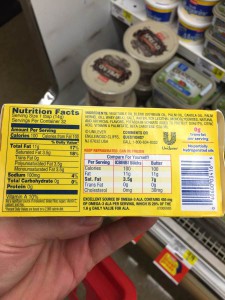A few months ago I mistakenly grabbed a box of “light butter” instead of regular butter. Since I was using it as an ingredient in popovers, it completely ruined my breakfast. “What is this evil substance?”, you wonder.
My history with butter substitutes goes back to when my grandparents and parents started using margarine in the 1970s. Margarine was one of those food products that marketing foisted on people as “healthier” (for unspecified reasons) than butter. And good consumers bought the stuff like crazy. Me? I put jam on my bread, instead.
What Is This Stuff?

Butter
Butter Ingredients: Sweet cream, Salt

Simple Ingredients
100 kCal/Tbsp – it’s practically metric. This is going to be easy. The salt has no food value; the calories are 100% from the cream. Now let’s look at the light butter:

Light Butter
Ingredients are: Water, butter. Note the calorie count: 50 kCal/tbsp – exactly half of the real butter.
Hypothesis: It’s butter, cut with half water, sold at the same price.
Supporting that hypothesis is the warning: DO NOT FREEZE. Why not? Because it’s an emulsion and it’s going to break apart into water and soggy butter foam if you freeze it. Butter, being fat, is going to freeze and thaw just fine. Also supporting that hypothesis is that fat, in the presence of water, becomes a good home for bacteria. Unlike real butter – which will more or less keep forever as long as you keep it away from air and water – this stuff will rot. When the Vasa was raised from Stockholm Harbor after sitting on the bottom from August 1628 until April 1961, they discovered sealed tubs of perfectly edible butter in her hold. So: that’s another point in favor of butter.
Returning to our analysis of ingredients: the light butter has 5g of fat, the real butter has 11g. That also aligns with our hypothesis that the light butter is slightly more than 50% water. It’s slightly less than 50% butter, too, to make room for the canola oil, fish oil, polysorbate (which is not merely “to preserve freshness” it’s also an industrial surfactant that doubtless comes in handy in emulsifying all that stuff with the butter and water).
The final evidence supporting the hypothesis that light butter is just water and (mostly) butter is the way it ruins your breakfast: try frying some eggs in this shit and what you’ll see is a great deal of steam coming up off your pan. By the time the steam is gone, you’ll be able to fry your eggs. But if you’re trying to bake with this stuff, you’ve significantly increased the water content of your recipe and you’re going to wind up with bricks of fail.
Accept No Substitutes
My first encounter with this substance was a decade ago, in which I had one of the worst meals of my life, which heavily depended on “I Can’t Believe It’s Not Butter” as an ingredient.

If you try to feed me this I will hurt you
This is the “Original” formulation. I fear the Advanced formulations, I really do. Note that it has “Fresh Butter Taste!” It’s 75% vegetable oil spread: the rest is probably water and/or butter, right?

You knew what was coming
Well, it’s not butter blended with water. It’s margarine blended with water. Here’s what’s interesting: it manages to have the same caloric value per serving as actual butter. Without being butter! Who’d’a thought that palm kernel oil, and soybean oil, and coconut oil, plus … water and milk – could, well, it doesn’t taste very much like butter at all, actually. I have no trouble believing it’s not butter because it tastes like crap. But at least it’s just as fattening and – if I’m a vegan – it’s still got milk in it to make sure it’s off the menu.
“Great for baking and cooking”? Uh, no. If you’re making a recipe that calls for corn/soybean oil and water, I suppose you could use this stuff as a substitute. But if you’re baking anything that’s even slightly water-sensitive, it’s going to ruin it. If you’re inclined to waste some money, take a bit of “ICBINB” and put it in a frying pan on high and watch what it does. Then do the same thing with butter.
What blows my mind about this glarp is that people cheerfully accept the “light” packaging and use it, without thinking for a fraction of a second whether the claims are anything other than literally true. Marketing assholes would not hesitate to sell you a product as “low sodium” if it dropped from 9g/tbsp of sodium down to 8.9g/tbsp. Oh, no! Shall we look at “low sodium salt” next?
We see this all the time, marketing weasels push a product like gummi bears as “low sodium” and “gluten free” – well, I totally expect my pure sugar candy to be gluten free, as long as the GMO gnomes haven’t devided to make a transgenic version of sugar that has gluten in it (in which case, why not just put wheat paste in the sugar candy and be done with it?) Another trick you’ll notice is the “ICBINB” has zero trans-fats. So does fucking butter. In other words: We’ve bent over backwards to produce something that’s just as fattening as butter, with all the sodium and calories, but it tastes faintly like bat guano and will ruin your baking.
Here are my suggestions:
Use butter.
If you care about your calories and sodium, use half as much butter.
If you’re baking, say, cornbread, use the amount of butter the recipe calls for, and just eat half as much.
PS – the Land O’ Lakes is for illustrative purposes only. Use KerryGold or President. There is a significant flavor difference between imported butters and the wisconsin butter food product stuff.

You were *that* close to tag this post “propaganda”, weren’t you?
oualawouzou@#1:
(looks around) Are your ninjas watching over my shoulder, or something?
I feel like the same argument goes for sugar vs “sweetener.”
Oh, fuck all the things that aren’t butter. I love butter, and refuse to use any of the pretend butters. Butter used in moderation is much better for you than using a fucktonne of the so-called healthy stuff.
I also won’t support Land O’ Lakes in any way, because they are appropriating assholes with their ‘Indian maiden’ bullshit, and they are not a Native company.
Ever since I set up housekeeping on my own (more than 30 years ago), I have been using real butter. You are correct that any substitute is crap. I don’t use that much butter over the course of a week, so it does not add significant anything to my diet except for flavor when I use it.
And if it is the truth, is it truly propaganda?
Shiv@#3:
Yup. “Low sugar” may mean “we reduced it from 30% sugar to 29% by adding water”
It appears that “low sodium” salt is often 50/50 sodium chloride and potassium chloride. Potassium chloride is not really very good for you, and … you know what’s going to happen, right? Someone who normally uses a pinch of salt is going to use 2 pinches of 50/50 “light” salt.
Sucralose production does appear to produce a sugary-tasting thing that’s not metabolizable. But I’m betting a lot of “low sugar” is just marketing and use of extenders.
Caine@#4:
I also won’t support Land O’ Lakes in any way, because they are appropriating assholes with their ‘Indian maiden’ bullshit, and they are not a Native company.
(clutches temples)
I. Did. Not. Catch. That.
Thanks for the heads up. Now I’ll feel morally self-justified using the KerryGold!
johnson catman@#5:
Yes! A small amount of real butter on a toasted bagel once a week, is better than an infinite amount of margarine glarpoid stuff on an infinity of bagels every day!!
Besides: there’s always jam!
And as the marketing people will tell you: jam has no fat in it.
So you can have low fat jam on your muffin one day, sugar-free butter on your muffin another day, and on sunday you can go gluten free by just eating buttered jam with a spoon.
In continuation of Marcus @6: “light” chocolate syrup (Nesquik, if you’re curious), “33% less sugar”. At a glance, the claim holds water: the nutrition facts do show a decrease of 33% in sugar (and calorie) between the regular and the light product.
But then, you may notice it is “33% less sugar per serving“. And sure enough, the regular product has a “recommended serving” of 30mL (numbers out of the air, to illustrate the point), and the light product has a “recommended serving” of 20ml. The syrup is just as sugary in both cases; the light product only assumes you’ll use less of it.
Cherry on top: the light product is sold in a container roughly 2/3 the capacity of the regular, but at the same price.
oualawouzou@#9:
Now you’ve done it.
(starts rummaging around for a certain photograph he did a decade ago…)
Artificial butter flavoring
I come from a country that produces huge quantities of high quality dairy product. It amazes me how many people (including my partner) use the low fat (water containing) and made up blends of shit. Marcus is quite right. If you are concerned about calories, eat less. One really good technology used here is to take ordinary butter (technically AMF still at that point) and to fractionate it using temperature controlled filtration into a ‘high’ and ‘low’ melting point fraction. You end up with two products that when made into butter give you a readily spreadable butter when cold and a butter perfect for making puff pastry in commercial kitchen environments (where ordinary butter is problematic as it melts too readily).
One of our chocolate producers marketed ‘low fat’ chocolate at one point. That’s right, you guessed it. They increased the sugar content by 30% to still give a suitable thick mouthfeel as it melted.
When I was a child, my mother took the warnings about butter seriously and gave us margarine with bread. I hated that stuff but ate it dutifully. When later research showed that butter was just fine and margarine was the bad stuff, I felt that I had been swindled and now slather butter on my bread with abandon.
Mano Singham @ # 13: … I … now slather butter on my bread with abandon.
Check to make sure it’s real abandon and not that bogus version they show on tv!
I went back to pure butter a few years ago, love it.
I had the margarine thing as a kid. I learned to use much less of it because otherwise you’d get the funky taste.
When ICBINB came out my mom insisted on getting nothing but that and I simply stopped using anything at all. I later learned she had real butter for cooking but when bread or pancakes came out she’d put out this stuff. Frankly the main thing I couldn’t believe about it was that it wasn’t toxic. I’ve never considered it to be edible.
As I recall, margarine was considered a healthier product because it was lower in saturated fat which we knew was not good for you. What wasn’t known was that trans fat in margarine is worse.
I don’t like the butter/water mixes but I have no problem with the butter/vegetable oil mixes (at least some of them).
For anyone who has ever wondered about those “unpronounceable” ingredients in processed food, a good book is Twinkie, Deconstructed by Steve Ettlinger. It makes no health claims, it simply goes down the ingredient list on the label of a typical product and explains what it is, how it is grown, mined or manufactured, and what it does for the recipe.
He was inspired to write the book when his daughter asked him, “Daddy, what’s polysorbate 60?”
I actually keep a container of low sodium salt around. I use it for making home made sports drink on the theory that if you need a sports drink, then you need to replace potassium as well as sodium. I don’t use it for anything else.
Then there’s Tropicana Trop50 fruit juices. It’s marketed as having half the sugar of the regular fruit juices. I naively bought some, then discovered from reading the ingredient list that it’s basically cut 50/50 with water. Then one day I was miserably sick, and asked housemate to get me some because it was one of the few things I thought I could keep down that had any calories in it. I described it as “pre-diluted for your convenience” because quite aside from the impact that the full strength fruit juice would would have on my blood sugar, I wasn’t sure I could keep down undiluted fruit juice and I sure didn’t feel up to diluting it myself.
Re: the gluten free candy. You might find this blog post amusing. It’s not my blog, but I find the concept of “preservative free salt” hilarious.
inquisitiveraven@#19:
wasn’t sure I could keep down undiluted fruit juice
Hmm, I should do a PSA about things to eat when you feel like throwing up. I have some experience with that…
I am not surprised at the gluten-free candy labeling. The current generation of celiacs seems to be paranoid and treat gluten like a poison, and is intensely worried about cross-contamination. So they want assurance that anything/everything is gluten-free (GF). I have seen the most absurd products questioned as to their GF status by celiacs, stuff that in no possible way could have gluten in it. Some celiacs won’t buy products unless they are produced in a GF facility.
As an old-time celiac I am amazed. Labeling/ingredient lists are so much better now than 10 years ago, and there are so many more GF products available. Yet the newbies are 10X more paranoid although life/products for celiacs are 10X better…
Btw, I am amazed that anyone would voluntary choose a GF diet. While quality has improved tremendously recently (thank you recreational glutenists!), most GF stuff is half as good as regular products, at 2X the price…
Mano @#13. I had the same margarine experience as Mano (probably around the same time too, as Mano has just beaten me to retirement). I switched to butter after my mother ruined the family oatmeal chocolate chip cookie recipe with margarine. As soon as I got a place of my own and tried the recipe with butter, I never used margarine for anything again.
Forgot to mention that any sane celiac absolutely loads the butter on any bread product, because most GF bread products are quite dry (ok, usually bone dry). Ordinary GF bread has to be warmed in a microwave to be palatable, and if you put enough butter on your bread you can pretend it is almost normal…
Roj:
Btw, I am amazed that anyone would voluntary choose a GF diet.
Me too. Bread is right up there with sex, only it has better crust.
Just for the information: ICBINB was originally created by a company that primarily made margarine, J.H. Filbert, Inc., makers of Mrs. Filbert’s. (My mother was an employee.) The company was sold long ago and who knows what they’ve done to the original formula? During development, samples were sent home with employess for family tasting and input a number of times. My late father, a serious butter lover, used to like it.
Pffff, Marcus, you’re doing it wrong ;-)
Roj, there is a GF bread baker near me that actually makes a palatable and tasty bread analogue. If anything it’s slightly too moist and gummy and has a kind of cakey texture but holds together well. It’s made from a mix of starches with all the usual gum and gunk that GF bakers use to simulate gluten. New Zealand is probably a little far away to be useful though sorry.
I have never bought any products labeled as “light”, because it feels like I’m getting ripped off. Fewer calories for the same price? What! When buying food, calories are exactly what I’m paying for. If I wanted to lose weight, I’d just eat less food. And, consequentially, pay less for it as well.
A few months ago I mistakenly grabbed a box of “light butter” instead of regular butter.
I have never experienced any incidents similar to your light butter problem only because nowadays, before buying any food, I always read the small print on the label and check the ingredients. It makes grocery shopping time consuming, but I see no other option. Most food on the shelves has some crap in it. The most common problem I see is palm oil being used to replace milk in foods like ice cream, chocolate and so on. I don’t want to accidentally get a mix of palm oil and sugar instead of an ice cream, so there’s no other option but to check the label before buying.